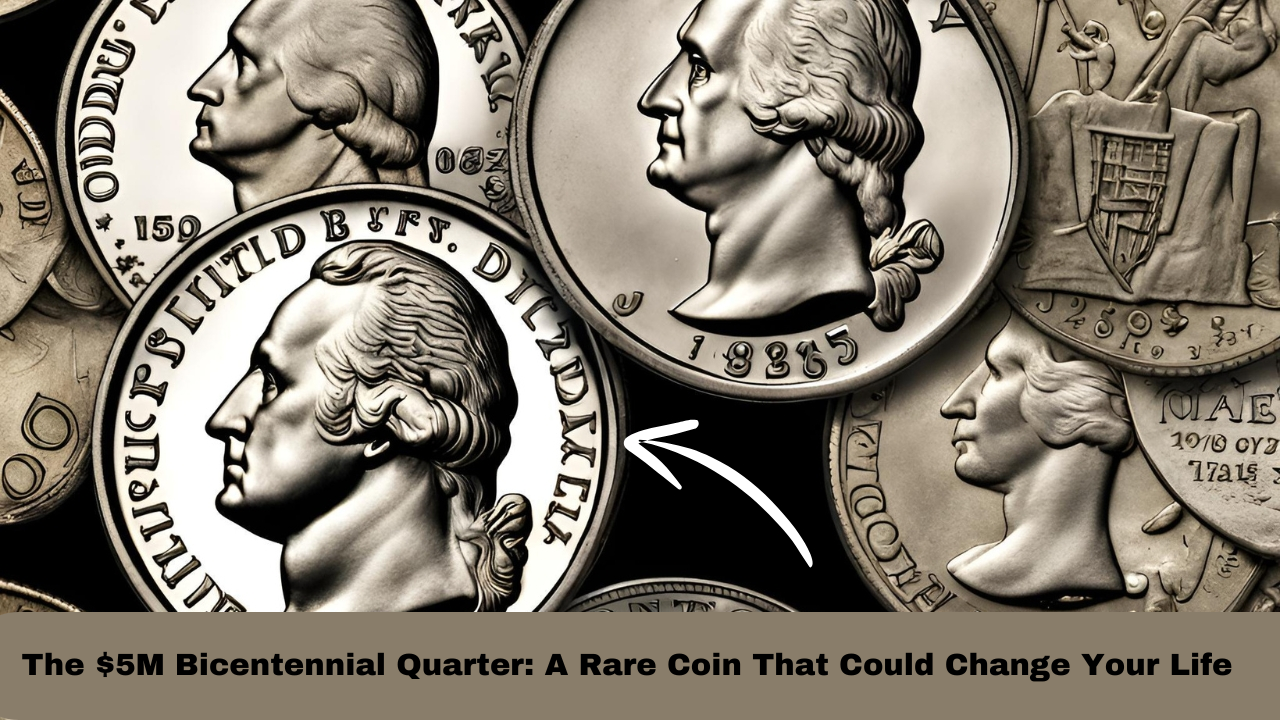The Bicentennial Quarter: A Brief History
The Bicentennial Quarter was issued in 1976 to commemorate the 200th anniversary of the United States’ Declaration of Independence. The coin was a departure from the standard design of the quarter, which traditionally featured George Washington. The reverse side of the Bicentennial Quarter was designed by Jack L. Ahr and features a depiction of the Liberty Bell, with a portion of the moon in the background—a reference to America’s achievements in space exploration. The coin was made of a copper-nickel alloy and was part of a broader set of commemorative coins, including the Bicentennial Half Dollar and the Bicentennial Dollar. While millions of Bicentennial Quarters were minted for circulation, they were produced with varying degrees of quality, and some developed unique errors or features that caught the attention of collectors.
Why Are Some Bicentennial Quarters Worth Millions?
The majority of Bicentennial Quarters are worth only their face value or slightly more, but certain rare coins have become highly valuable due to unique characteristics, errors, or special editions. There are three primary factors that contribute to the extraordinary value of these coins:
1. Minting Errors
Minting errors are one of the key reasons certain Bicentennial Quarters are worth far more than their face value. The U.S. Mint sometimes produces coins with defects or mistakes, which make them unique and highly desirable among collectors. Some common minting errors in Bicentennial Quarters include:
- Off-Center Strikes: When the coin is not perfectly aligned during the striking process, the design appears misaligned, making the coin distinctive and rare.
- Double Die Errors: This occurs when the die used to strike the coin malfunctions, causing certain features, such as the date or lettering, to appear doubled.
- Missing Mint Marks: Most Bicentennial Quarters feature a mint mark to indicate where they were produced. Occasionally, a quarter may be released without this mint mark, making it significantly rarer.
- Misplaced or Incorrect Design Elements: Any mistake in the placement of the Liberty Bell or other design elements can increase the coin’s rarity and value.
2. Coin Quality and Grading
The condition of the coin, known as its “grade,” plays a significant role in determining its value. Coins are graded by professional numismatists on a scale of 1 to 70, with a grade of 70 representing a perfect, uncirculated coin. A coin’s grade is determined by factors such as the presence of wear, scratches, or other forms of damage. High-quality Bicentennial Quarters, particularly those graded above MS-65 (Mint State 65), are highly sought after by collectors and can fetch far more than their face value. Coins in near-perfect condition with minimal wear are rare, making them valuable to collectors who focus on high-grade specimens.
3. Limited-Edition Proofs and Silver Coins
While the majority of Bicentennial Quarters were made from copper-nickel, the U.S. Mint also produced special editions for collectors. These coins were struck with a higher level of care to create a shiny, mirror-like finish, known as proof coins. Bicentennial proof sets, which included the quarter, were released in limited numbers, and coins from these sets can command higher prices, particularly if they are in perfect condition. Additionally, the Mint produced silver versions of the Bicentennial coins as part of a special silver proof set. These silver coins are often more valuable than their copper-nickel counterparts due to both the limited production and the intrinsic value of silver, making them highly desirable for investors.
Bicentennial Quarters Worth Over $500,000: The Special Cases
While most Bicentennial Quarters are worth their face value or a small premium for certain minting errors or proof sets, a select few have become worth hundreds of thousands, or even millions, at auction. The following are examples of such rare coins:
1. The 1976 No Mint Mark Quarter
One of the rarest Bicentennial Quarters is the 1976 No Mint Mark variety. Some coins were released without the mint mark, a mistake that became widely recognized by collectors. Due to the rarity of this error, one of these No Mint Mark Bicentennial Quarters sold for nearly $5 million at auction. The combination of the minting error and the strong demand from error coin collectors made this quarter exceptionally valuable.
2. The 1976-S Proof Set Quarter
Proof sets containing Bicentennial coins were made for collectors and typically included higher-quality versions of the coins. A few proof coins, such as the 1976-S Bicentennial Quarter, were found in near-perfect condition and sold for over $500,000 at auction. The appeal of these coins lies not only in their condition but also in their silver content and limited edition nature.
3. The 1976 Double Die Quarter
A 1976 Bicentennial Quarter with a double die error features the design being imprinted more than once, causing the date and lettering to appear doubled. This error makes the coin highly desirable to collectors who specialize in misprints. Some double die Bicentennial Quarters have sold for over $200,000, particularly those in perfect or near-perfect condition.
4. The 1976 Off-Center Quarter
Off-center coins, like the 1976 Bicentennial Quarter with an off-center strike, are highly prized by collectors. A dramatic off-center strike creates a visually distinctive coin that stands out from standard coins. One such off-center Bicentennial Quarter was sold for over $500,000 due to its rarity and unique appearance.
How to Identify Rare Bicentennial Quarters
Identifying a rare Bicentennial Quarter involves examining a few key factors that could indicate its value:
- Examine the Mint Mark: Check for any mint marks (D, S, or no mint mark). Missing mint marks are valuable, particularly on specific years and types.
- Look for Errors: Inspect the coin for any signs of minting errors, such as off-center strikes, double die errors, or misplaced design elements.
- Check the Coin’s Grade: The higher the grade, the more valuable the coin. Coins with minimal wear, clear features, and no damage are more valuable.
- Consult Experts: If you’re unsure about a coin’s authenticity or value, seek the help of professional numismatists or send the coin to a grading service for evaluation.
Conclusion
The Bicentennial Quarter remains one of the most iconic coins in U.S. history, and its rarer varieties can be worth a small fortune. Minting errors, high-quality coins, and limited-edition proofs all contribute to the extraordinary value of some of these quarters. For collectors, these rare coins offer an exciting opportunity to own a piece of American history, while also potentially making a significant investment. Whether you’re searching for a unique minting error or looking for high-quality examples, Bicentennial Quarters continue to be highly coveted in the world of numismatics.




